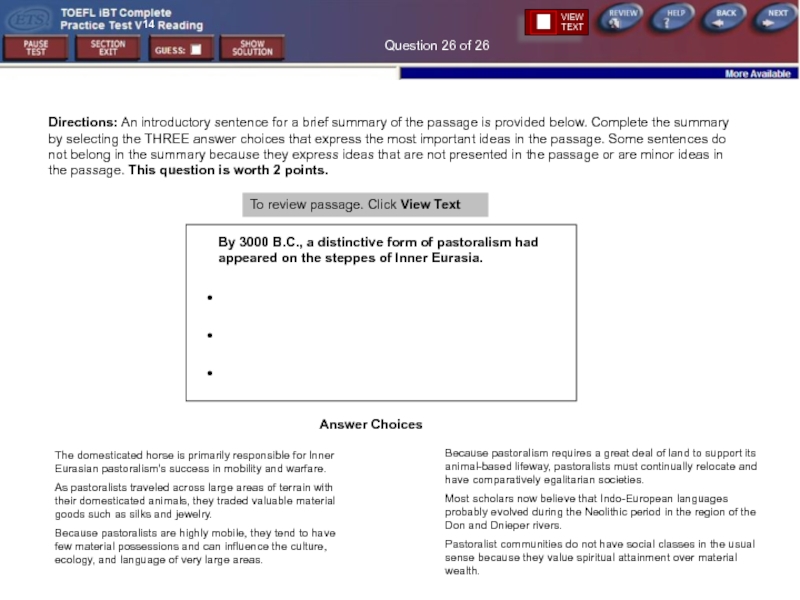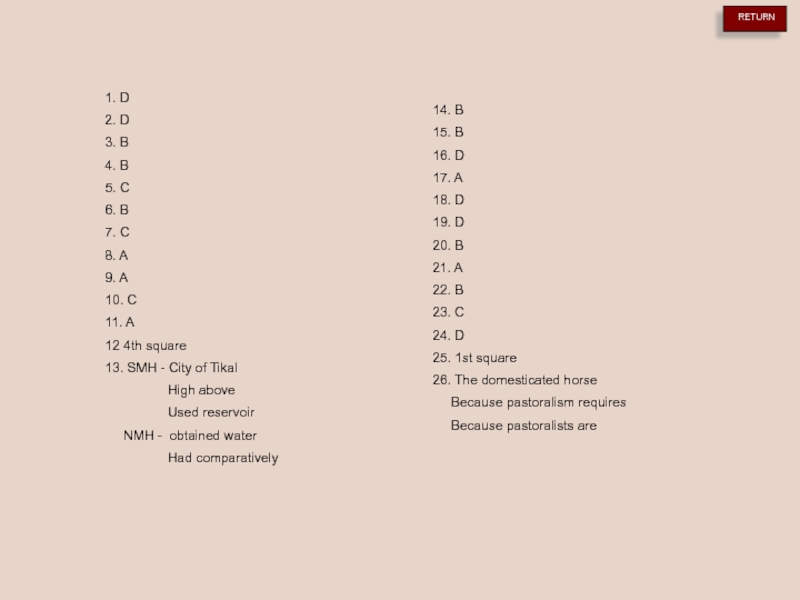- Главная
- Разное
- Дизайн
- Бизнес и предпринимательство
- Аналитика
- Образование
- Развлечения
- Красота и здоровье
- Финансы
- Государство
- Путешествия
- Спорт
- Недвижимость
- Армия
- Графика
- Культурология
- Еда и кулинария
- Лингвистика
- Английский язык
- Астрономия
- Алгебра
- Биология
- География
- Детские презентации
- Информатика
- История
- Литература
- Маркетинг
- Математика
- Медицина
- Менеджмент
- Музыка
- МХК
- Немецкий язык
- ОБЖ
- Обществознание
- Окружающий мир
- Педагогика
- Русский язык
- Технология
- Физика
- Философия
- Химия
- Шаблоны, картинки для презентаций
- Экология
- Экономика
- Юриспруденция
Test TPO 14. Maya. Water problems. (Section 2) презентация
Содержание
- 1. Test TPO 14. Maya. Water problems. (Section 2)
- 2. You can use the countdown timer at
- 3. Set the timer before doing
- 4. Question 1 of 26
- 5. Question 2 of
- 6. Question 3
- 7. Question 4
- 8. Question 5
- 9. Question 6
- 10. Question 7
- 11. Question 8
- 12. Question 9
- 13. Question 10
- 14. Question 11
- 15. Look at the four squares
- 16. Question 13
- 19. The word
- 20. According
- 21. The
- 22. In
- 23. According
- 24. In
- 25. The
- 26. The
- 27. According
- 28. According
- 29. Which
- 30. Look at the four squares
- 31. Directions:
- 33. Congratulations! You have completed this practice test.
- 34. 1. D 2. D 3. B
- 35. Are you sure you want to exit
- 36. Your answers will be saved with the
- 37. OK When your computer asks you if
- 38. OK When your computer asks you if
Слайд 2You can use the countdown timer at the left bottom corner
press this button to set the timer
pause countdown
Input a number
start countdown
Слайд 3
Set the timer before doing the test. Standard time for doing
If you cannot see the timer or if you cannot set the timer, you’ll need to install flash player. Click here to download and install adobe flash player.
Слайд 4
Question 1 of 26
Why does the author call the Mayan homeland
To illustrate how the climate of the Mayan homeland varied from region to region
To explain how the climate of the Mayan homeland is similar to that of a jungle or tropical rainforest
To emphasize the vast size of the area that comprised the Mayan homeland in ancient times
To make the point that the Mayan homeland is climatically more complex than is generally assumed
Слайд 5
Question 2 of 26
Which of the following is NOT mentioned in
The annual rainfall was greater in the south.
The population density was lower in the north.
Agricultural productivity was greater in the south.
Rainfall was more unpredictable and variable in the south.
Paragraph 2 is marked with ◆
Слайд 6
Question 3 of 26
Which of the following statements about ancient and
Modern agricultural methods have solved many of the ancient problems of farming in the Yucatan Peninsula.
Ancient Mayan farmers may have been somewhat more successful at farming in the Yucatan Peninsula than farmers are today.
Farming today is easier than in the past because environmental changes in the Yucatan Peninsula have increased available rainfall.
The Yucatan soils in which ancient farmers worked were richer, more productive, and thicker than they are today.
Paragraph 2 is marked with ◆
Слайд 7
Question 4 of 26
The word 【paradoxically】 in the passage is closest
usually
surprisingly
understandably
predictably
Слайд 8
Question 5 of 26
The phrase 【The likely explanation】 in the passage
the southern Maya areas received more rainfall than the northern areas
modern archaeologists have difficulty understanding ancient droughts
water problems were most severe in the wet south
land surface in the south is so high above the water table
Слайд 9
Question 6 of 26
Which of the following statements about the availability
The construction of wells was an uncommon practice in both the north and the south because it was too difficult to dig through the karst.
In most areas in the north and the south, rainwater was absorbed directly into the porous karst.
The water table was an important resource for agriculture in both the north and the south of the Yucatan Peninsula.
The lack of surface water in both the north and the south was probably due to the fact that most of it was quickly used up for agricultural purposes.
Paragraph 3 is marked with ◆
Слайд 10
Question 7 of 26
According to paragraph 3, why was the southern
The presence of numerous sinkholes and wells interfered with farming.
Southern soil lacked the depth crops needed for growth.
Underground water was too far below the surface to reach.
The presence of karst caused frequent flooding.
Paragraph 3 is marked with ◆
Слайд 11
Question 8 of 26
Which of the sentences below best expresses the
Southern Maya populations obtained the water they needed for the dry season by collecting and storing rainwater in sealed depressions.
The Maya are credited with creating methods for modifying natural rainwater and storing it.
Leaks in the karst caused difficulties in the creation of reservoirs, which were needed to store water for the dry season.
Southern Mayans were more successful at collecting rain than storing it during dry seasons.
Слайд 12
Question 9 of 26
What can be inferred from paragraph 4 about
They depended upon water and food that had been stored for use during the dry season.
They obtained drinking water and water for crop irrigation from Coba dikes.
They located their population centers near a lake where water was available for drinking and watering crops.
They moved locations every 18 months to find new croplands and water sources.
Paragraph 4 is marked with ◆
Слайд 13
Question 10 of 26
The word 【prolonged】 in the passage is closest
unusual
unexpected
extended
disastrous
Слайд 14
Question 11 of 26
The word 【exhausted】 in the passage is closest
used up
reduced
wasted
relied upon
Слайд 15
Look at the four squares [■]that indicate where the following sentence
The difference between the two climates challenged the Maya who had to deal with both.
Where would the sentence best fit?
■ 1
■ 2
■ 3
■ 4
Question 12 of 26
Слайд 16
Question 13 of 26
Directions: Select from the seven phrases below the
Answer Choices
To review passage. Click View Text
Southern Mayan Homeland
●
●
●
City of Tikal
Predictable rainfall
High above water table
Used reservoirs
Obtained water from wells
Dramatically improved corn crops
Had comparatively thin layer of soil
●
●
Northern Mayan Homeland
1
2
3
4
5
6
7
2
3
4
5
6
7
1
2
3
4
5
6
7
1
2
3
4
5
6
7
1
2
3
4
5
6
7
1
2
3
4
5
6
7
1
Слайд 19
The word 【prestige】 in the passage is closest in meaning to
interest
status
demand
profit
Question 14 of 26
Слайд 20
According to paragraph 1, what made it possible for Inner Eurasian
It involved the domestication of several types of animals.
It was based primarily on horses rather than on other animals.
It borrowed and improved upon European ideas for mobility and warfare.
It could be adapted to a wide variety of environments.
Question 15 of 26
Paragraph 1 is marked with ◆
Слайд 21
The word 【profound】 in the passage is closest in meaning to
strange
positive
direct
far-reaching
Question 16 of 26
Слайд 22
In paragraph 2, why does the author contrast pastoralists with agriculturalists?
To
To identify some advantages that mobile societies have over immobile societies
To demonstrate that ecological principles that apply to pastoralism do not apply to agriculturalism
To argue that agriculturalism eventually developed out of pastoralism
Question 17 of 26
Paragraph 2 is marked with ◆
Слайд 23
According to paragraph 2, pastoralists tend to
prefer grazing their animals on
consume comparatively large amounts of food and clothing
avoid eating plant foods
move from place to place frequently
Question 18 of 26
Paragraph 2 is marked with ◆
Слайд 24
In paragraph 3, why does the author discuss languages spoken in
To emphasize the frequency with which Indo-European languages changed as a result of the mobile nature of pastoralism
To indicate one method linguists use to determine that inhabitants of the Don and Dnieper river area had taken up stock breeding
To provide evidence that Indo-European languages have their roots in what is now Turkey
To provide evidence that pastoralist societies can exercise cultural influence over a large area
Paragraph 3 is marked with ◆
Question 19 of 26
Слайд 25
The word 【striking】 in the passage is closest in meaning to
reliable
noticeable
convincing
violent
Question 20 of 26
Слайд 26
The word 【exploit】 in the passage is closest in meaning to
use
depart from
pay attention to
travel across
Question 21 of 26
Слайд 27
According to paragraph 4, the fact that pastoralist communities are subject
relocate less frequently than they would otherwise
have households that are more or less equal in wealth
become self-sufficient in the manufacture of silk and jewelry
share large material surpluses with neighboring communities
Paragraph 4 is marked with ◆
Question 22 of 26
Слайд 28
According to paragraph 4, all of the following are true of
It exists and has existed to some degree in most pastoral societies.
It is most marked during periods of military conquest.
It is expressed in the form of a rigid hierarchy based largely on heredity.
It is usually too insignificant to be discussed in terms of class differences.
Paragraph 4 is marked with ◆
Question 23 of 26
Слайд 29
Which of the sentences below best expresses the essential information in
Despite the fact that wealth is relatively evenly distributed in pastoral societies, gender inequality still exists because only men can acquire military skills and social status.
Inequalities of gender existed in pastoralist societies until most communities began to require women to possess the same skills as men and take part in the military.
Inequalities of gender in pastoralist societies were caused by steep hierarchies of wealth and differences in military training between men and women.
In pastoral societies, gender inequality is comparatively mild because wealth is relatively evenly distributed and women have to learn most of the same skills that men do.
Question 24 of 26
Слайд 30
Look at the four squares [■]that indicate where the following sentence
There is a good reason for this.
Where would the sentence best fit?
■ 1
■ 2
■ 3
■ 4
Question 25 of 26
Слайд 31
Directions: An introductory sentence for a brief summary of the passage
To review passage. Click View Text
By 3000 B.C., a distinctive form of pastoralism had appeared on the steppes of Inner Eurasia.
●
●
●
Answer Choices
The domesticated horse is primarily responsible for Inner Eurasian pastoralism's success in mobility and warfare.
As pastoralists traveled across large areas of terrain with their domesticated animals, they traded valuable material goods such as silks and jewelry.
Because pastoralists are highly mobile, they tend to have few material possessions and can influence the culture, ecology, and language of very large areas.
Because pastoralism requires a great deal of land to support its animal-based lifeway, pastoralists must continually relocate and have comparatively egalitarian societies.
Most scholars now believe that Indo-European languages probably evolved during the Neolithic period in the region of the Don and Dnieper rivers.
Pastoralist communities do not have social classes in the usual sense because they value spiritual attainment over material wealth.
Question 26 of 26
Слайд 33Congratulations!
You have completed this practice test.
Save / exit the test
Review
Obtain answer keys
独 家 制 作
Слайд 34
1. D
2. D
3. B
4. B
5. C
6. B
7. C
8. A
9. A
10. C
11.
12 4th square
13. SMH - City of Tikal
High above
Used reservoir
NMH - obtained water
Had comparatively
14. B
15. B
16. D
17. A
18. D
19. D
20. B
21. A
22. B
23. C
24. D
25. 1st square
26. The domesticated horse
Because pastoralism requires
Because pastoralists are
Слайд 35Are you sure you want to exit the test?
YES
NO
Exit the test.
Return to the last question and resume doing the test.
Слайд 36Your answers will be saved with the file.
Your answers will
Do you want to save your answers?
YES
NO



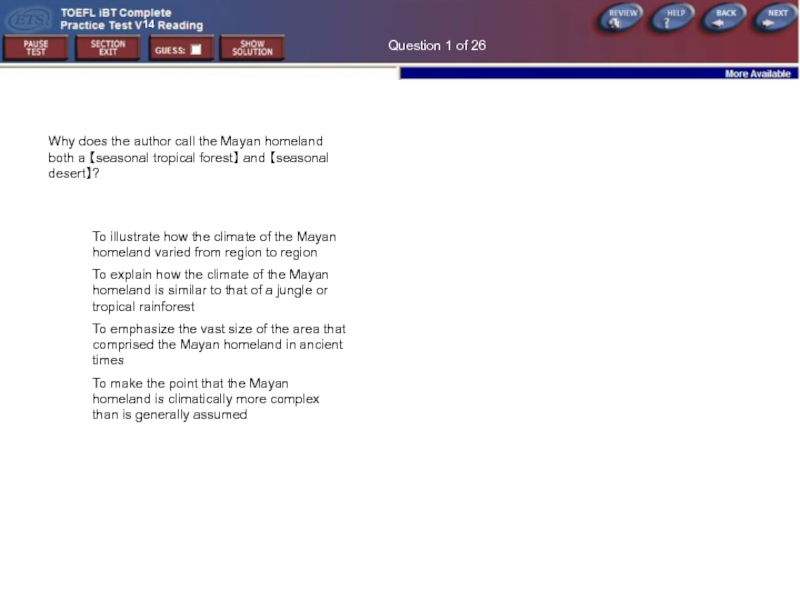
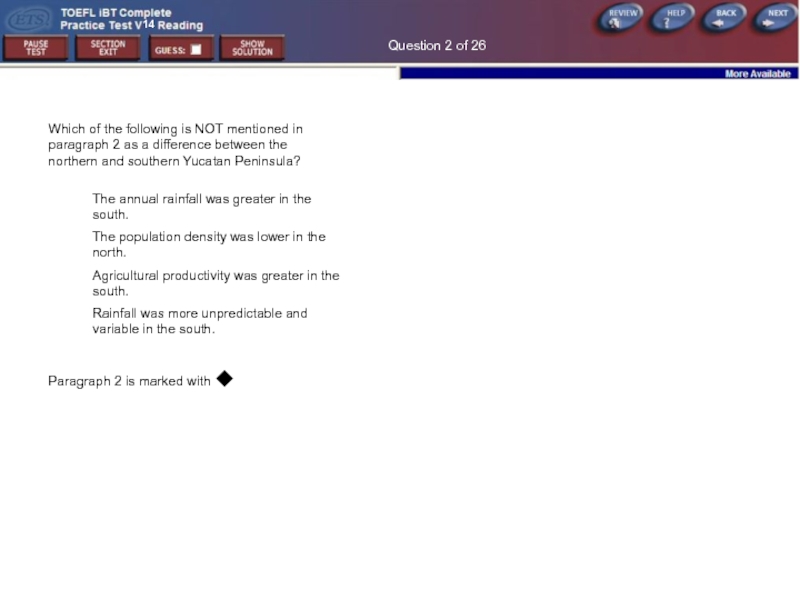
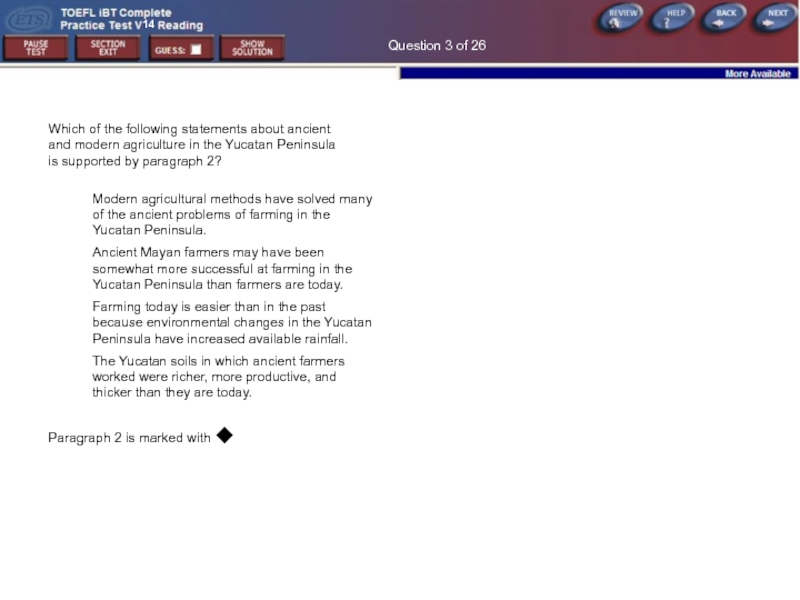


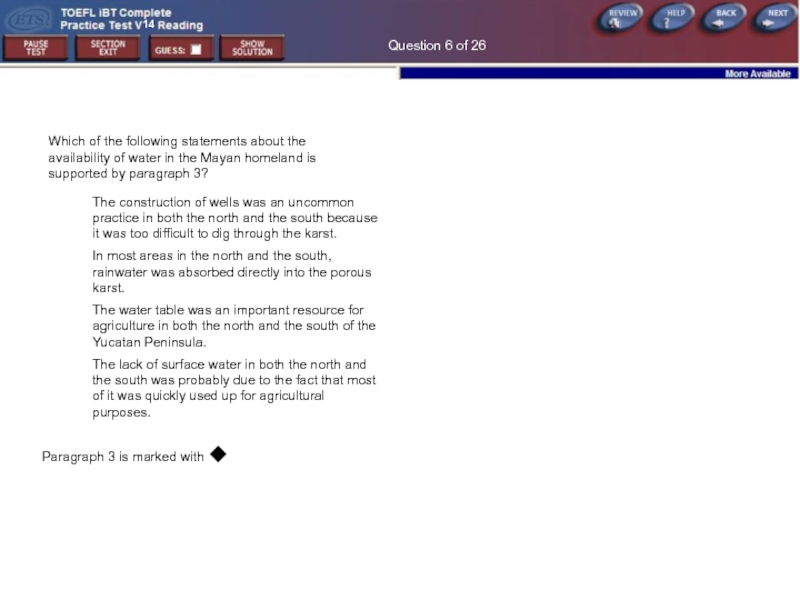
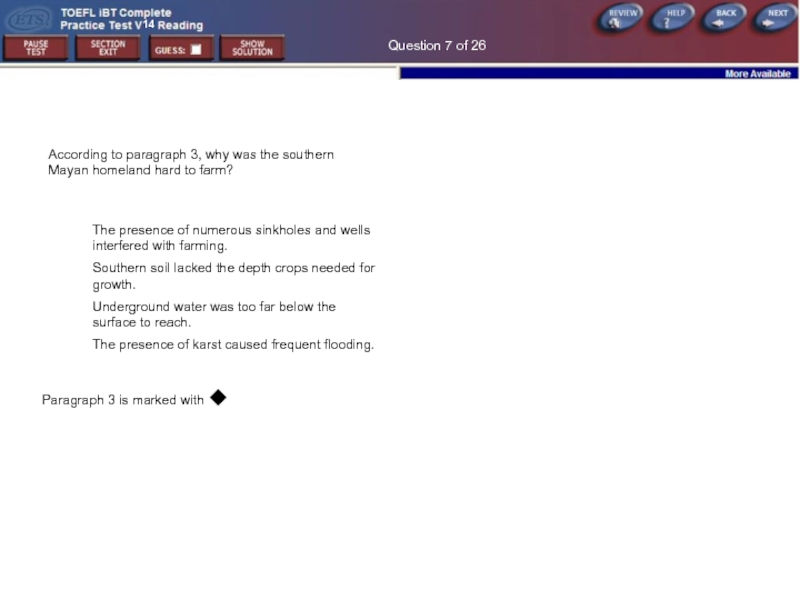
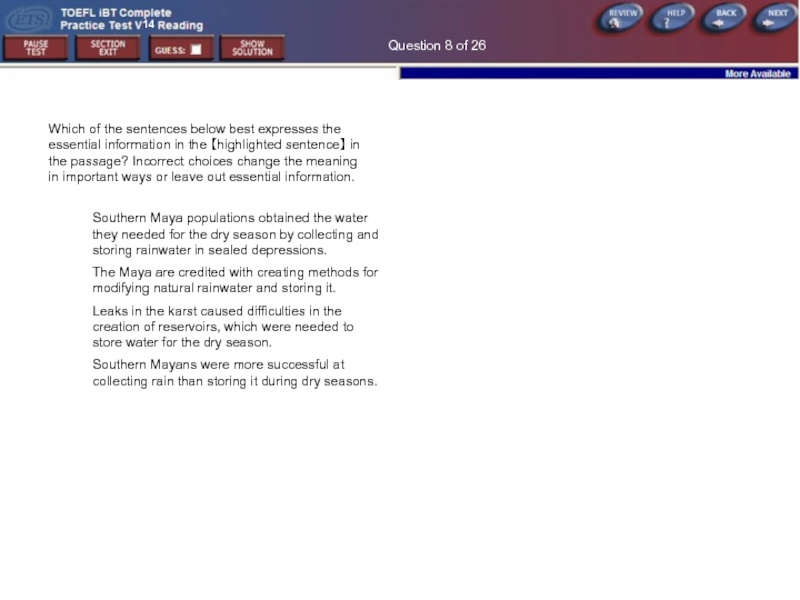
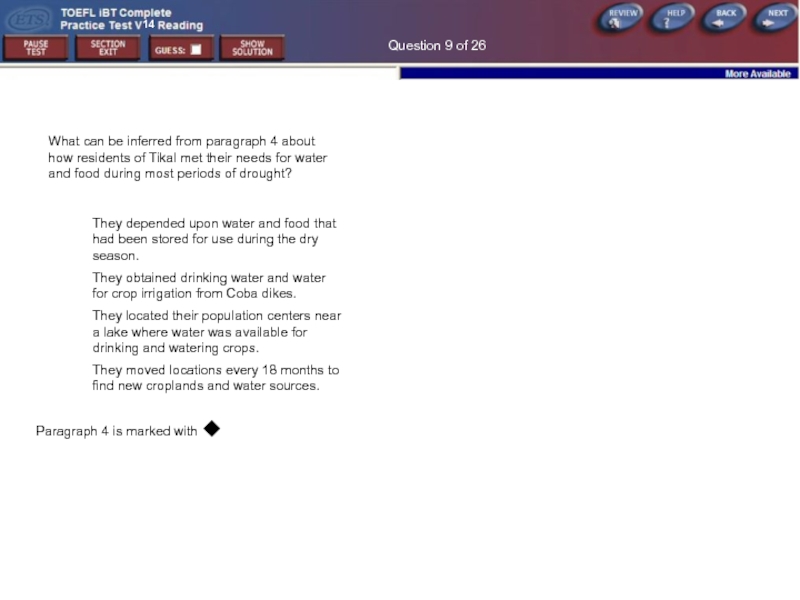


![Look at the four squares [■]that indicate where the following sentence could be added to](/img/tmb/4/312518/b77f26d4a6cba65223c2efb50fe5679c-800x.jpg)
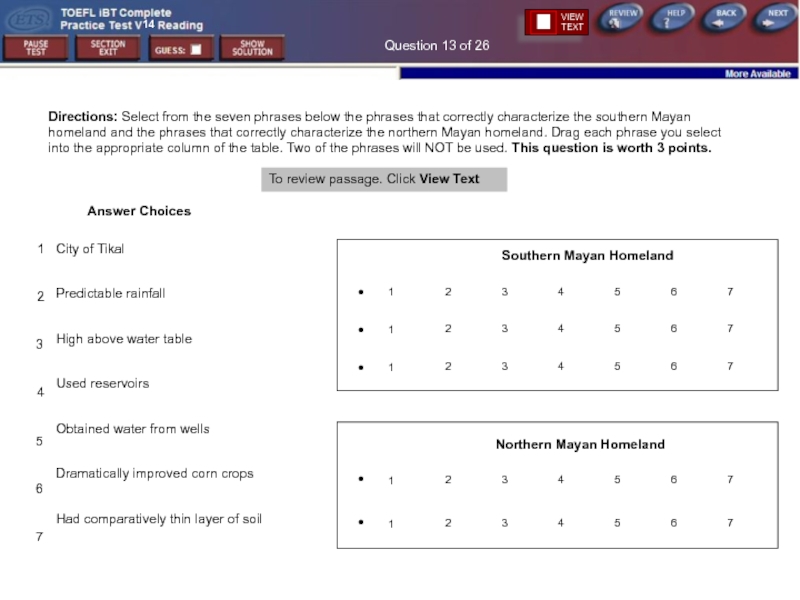



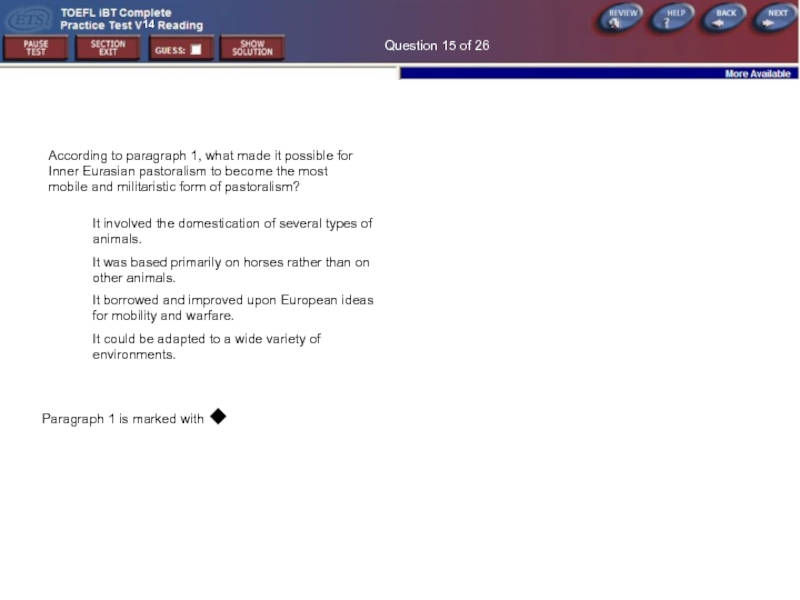

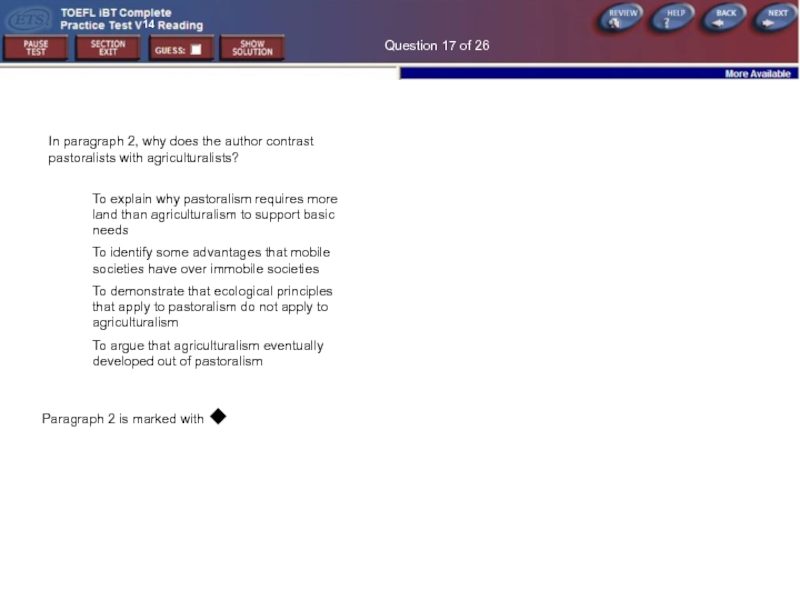
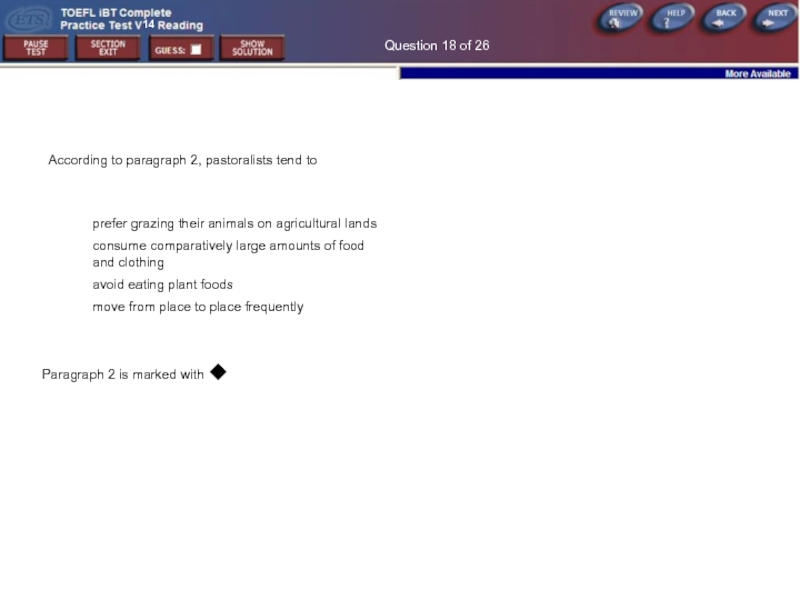
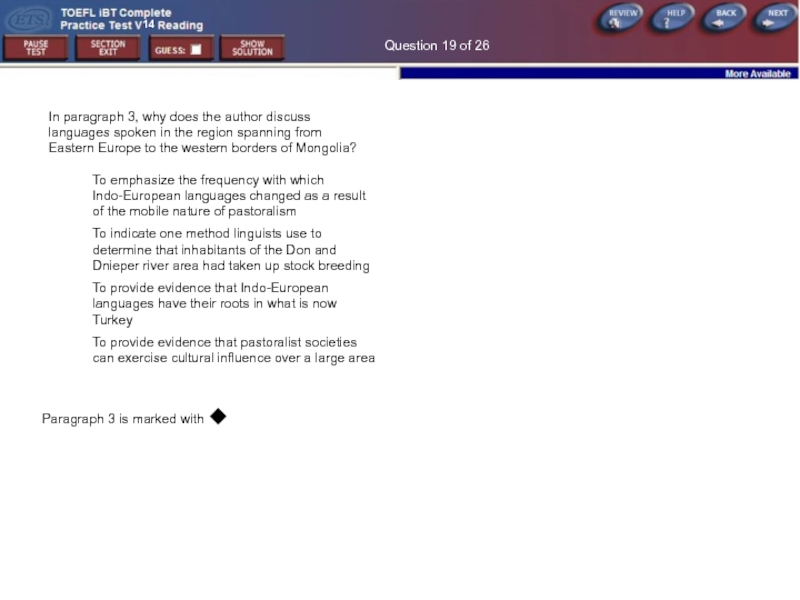


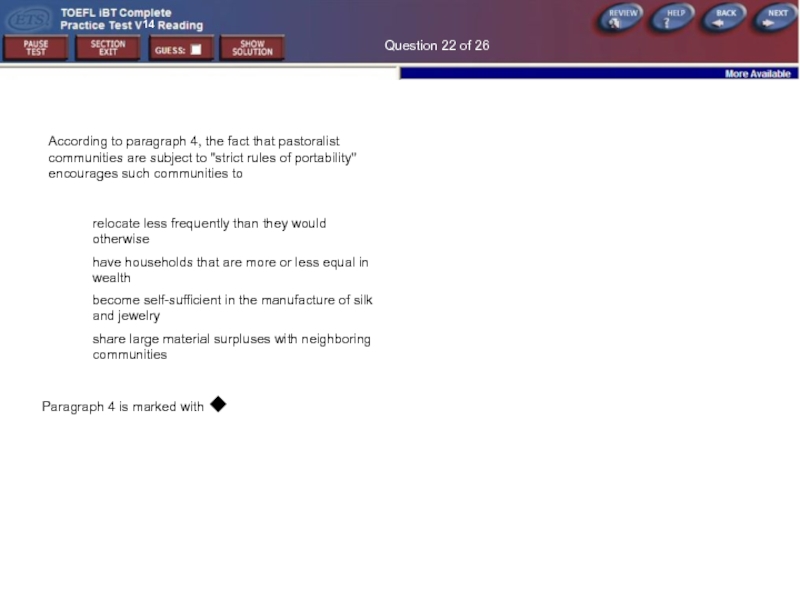
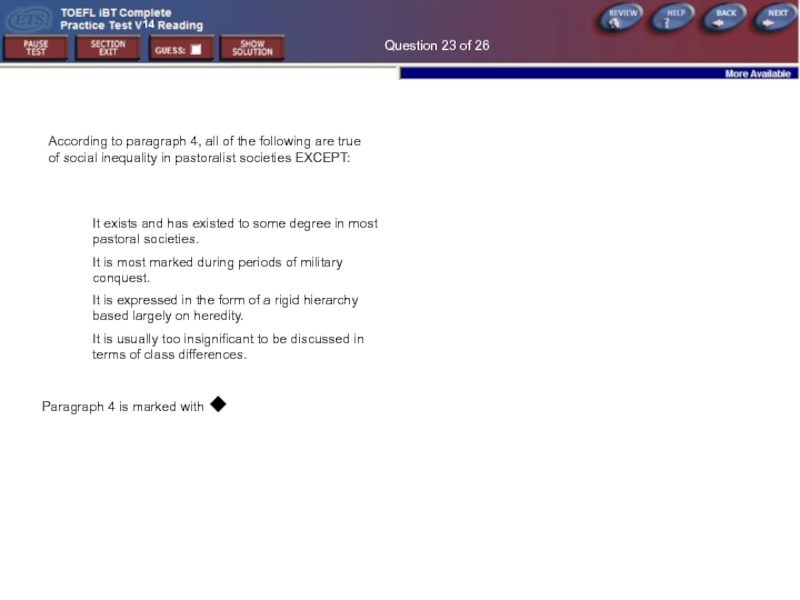
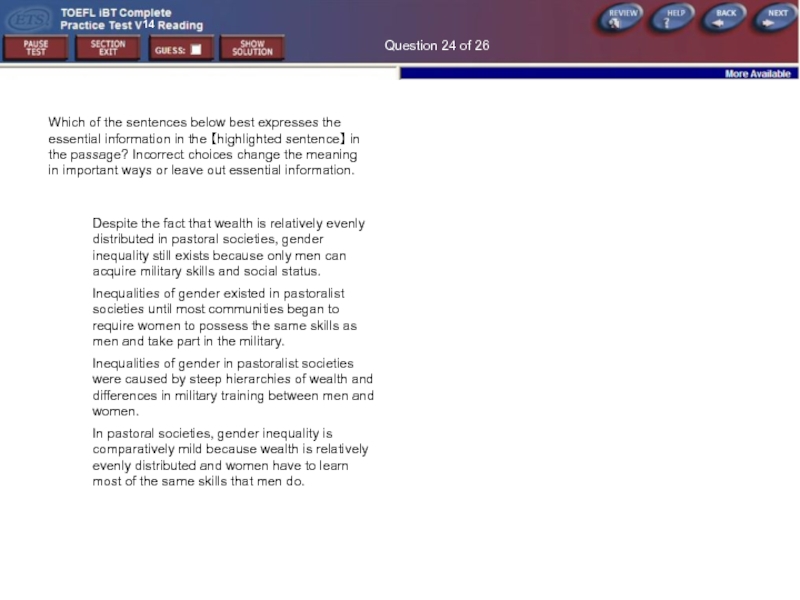
![Look at the four squares [■]that indicate where the following sentence could be added to](/img/tmb/4/312518/55991c0d3794c07a6f420aa8cc015790-800x.jpg)
